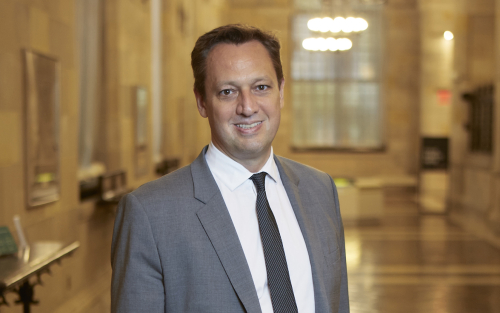How the Fed Changes the Size of Its Balance Sheet

The size of the Federal Reserve’s balance sheet increased greatly between 2009 and 2014 owing to large-scale asset purchases. The balance sheet has stayed at a high level since then through the ongoing reinvestment of principal repayments on securities that the Fed holds. When the Federal Open Market Committee (FOMC) decides to reduce the size of the Fed’s balance sheet, it is expected to do so by gradually reducing the pace of reinvestments, as outlined in the June 2017 addendum to the FOMC’s Policy Normalization Principles and Plans. How do asset purchases increase the size of the Fed’s balance sheet? And how would reducing reinvestments reduce the size of the balance sheet? In this post, we answer these questions by describing the mechanics of the Fed’s balance sheet. In our next post, we will describe the balance sheet mechanics with respect to agency mortgage-backed securities (MBS).
The Role of Central Bank Lending Facilities in Monetary Policy

Central bank lending facilities were vital during the financial crisis of 2007-08 when many banks and nonbank financial institutions turned to them to meet funding needs as private funding dried up. Since then, there has been renewed interest in the design of central bank lending facilities in the post-crisis period.
The New York Fed DSGE Model Forecast—May 2017
This post presents our quarterly update of the economic forecasts generated by the Federal Reserve Bank of New York’s dynamic stochastic general equilibrium (DSGE) model. We describe very briefly our forecast and its change since February 2017. As usual, we wish to remind our readers that the DSGE model forecast is not an official New York Fed forecast, but only an input to the Research staff’s overall forecasting process. For more information about the model and variables discussed here, see our DSGE Model Q & A .
QE Frictions: Could Banks Have Favored Refinancing over New Purchase Borrowing?
The FRBNY DSGE Model Forecast—February 2017
This post presents the latest update of the economic forecasts generated by the Federal Reserve Bank of New York’s (FRBNY) dynamic stochastic general equilibrium (DSGE) model. We introduced this model in a series of blog posts in September 2014 and published forecasts twice a year thereafter. With this post, we move to a quarterly release schedule, and highlight how our forecasts have changed since November 2016.
Readers should keep in mind that the DSGE model forecast is not an official New York Fed forecast, but only an input to the Research staff’s overall forecasting process. For more information about the model and the variables discussed here, see our DSGE Model Q & A.
Hey, Economist! Tobias Adrian Reflects on His Work at the N.Y. Fed before Heading to the IMF

Tobias Adrian is leaving the New York Fed to become the Financial Counselor and Director of the Monetary and Capital Markets Department at the International Monetary Fund (IMF). In announcing Adrian’s appointment, Christine Lagarde, managing director of the IMF, described Tobias as “internationally highly regarded for his insightful analytical work.” Until he starts his new position at the beginning of 2017, Adrian will be winding down his service as Senior Vice President of the New York Fed and Associate Director of the Bank’s Research and Statistics Group. Before he moves on to the IMF, Adrian shared some insight on his time at the Bank.
At the N.Y. Fed: Capital Flows, Policy Dilemmas, and the Future of Global Financial Integration

The New York Fed recently hosted the third bi-annual Global Research Forum on International Macroeconomics and Finance, an event organized in conjunction with the European Central Bank (ECB) and the Federal Reserve Board. Bringing together a diverse group of academics, policymakers, and market participants, the two-day conference (November 17-18) was aimed at promoting discussion of frontier research on empirical and theoretical issues in international finance, banking, and open-economy macroeconomics. Understanding the drivers and implications of international capital flows was a major area of focus, along with the policy challenges posed by global financial integration.
The FRBNY DSGE Model Forecast—November 2016
This post presents the latest update of the economic forecasts generated by the Federal Reserve Bank of New York’s (FRBNY) dynamic stochastic general equilibrium (DSGE) model.
Escaping Unemployment Traps

Economic activity has remained subdued following the Great Recession. One interpretation of the listless recovery is that recessions inflict permanent damage on an economy’s productive capacity. For example, extended periods of high unemployment can lead to skill losses among workers, reducing human capital and lowering future output. This notion that temporary recessions have long-lasting consequences is often termed hysteresis. Another explanation for sluggish growth is the influential secular stagnation hypothesis, which attributes slow growth to long-term changes in the economy’s underlying structure. While these explanations are observationally similar, they have very different policy implications. In particular, if structural factors are responsible for slow growth, then there might be little monetary policy can do to reverse this trend. If instead hysteresis is to blame, then monetary policy may be able to reverse slowdowns in potential output, or even prevent them from occurring in the first place.
From the Vault: Does Forward Guidance Work?
This post takes a look at research assessing the effectiveness of forward guidance in monetary policy communications.











 RSS Feed
RSS Feed Follow Liberty Street Economics
Follow Liberty Street Economics